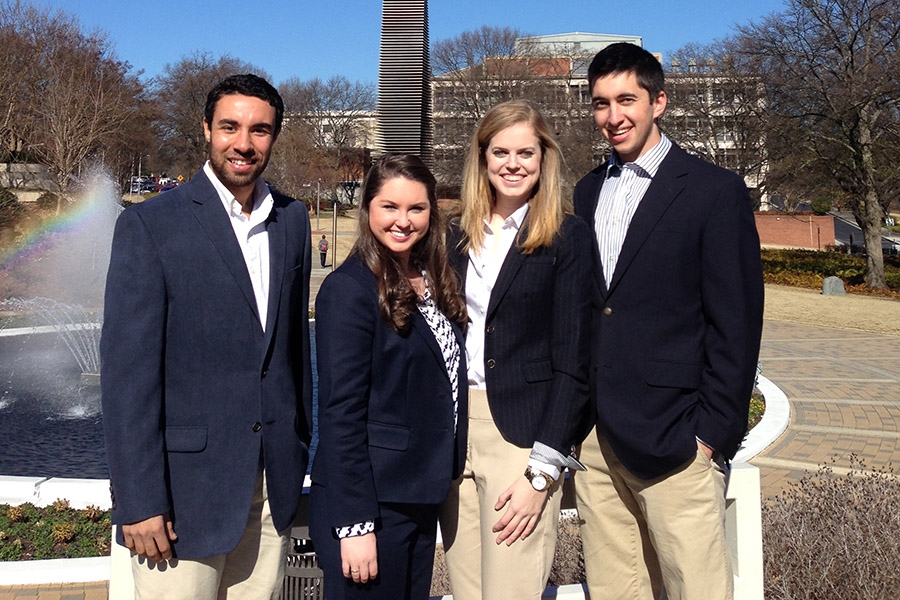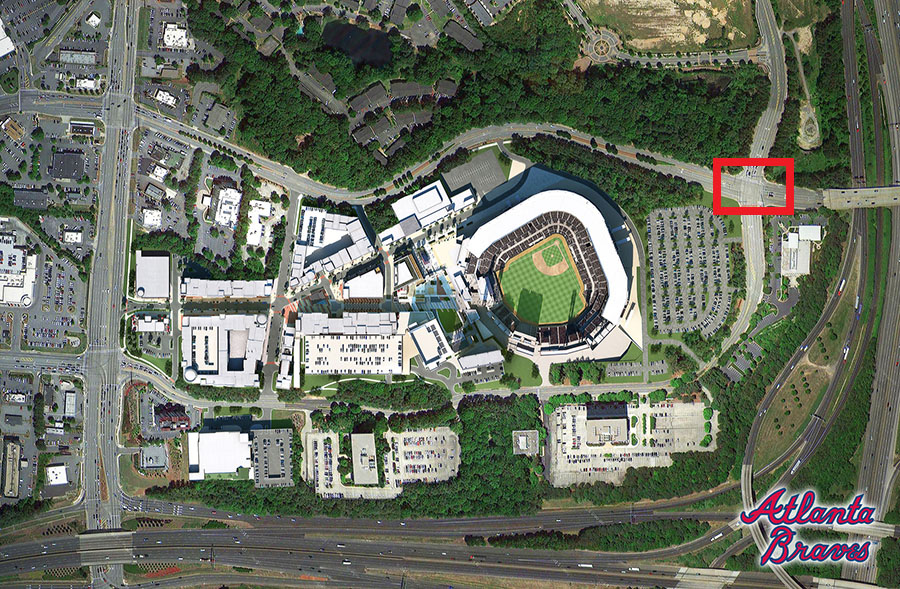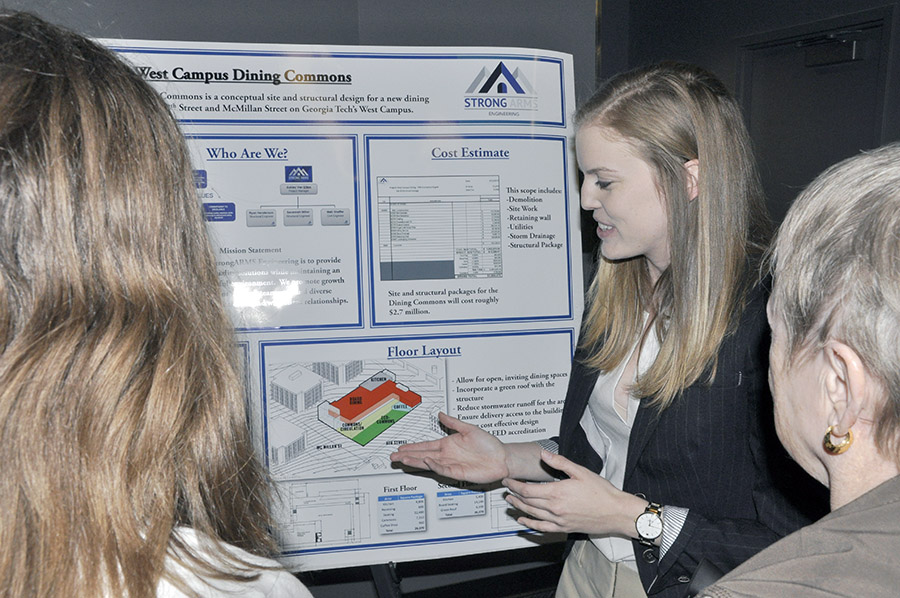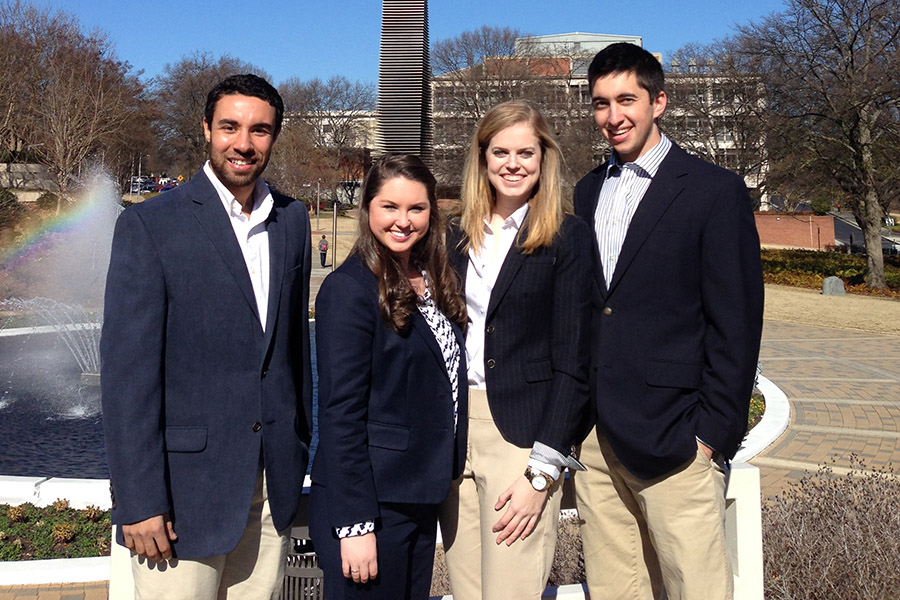
IF YOU GOCapstone Design Expo > Opens at 4:30 p.m. CEE’s two teams will be in the Red area at tables R3 and R9. |
Among the nearly 200 teams at the spring 2015 Capstone Design Expo April 23 were two groups from the School of Civil and Environmental Engineering — the first time CEE was represented at the huge display of senior design projects from across Georgia Tech.
The idea behind the expo is to showcase the real-world projects students have tackled this semester in their design courses. The projects pull together the students’ four years of learning to help the team’s sponsoring agency or company deal with an actual issue.
The CEE teams showcased their designs for a new dining hall on the west side of Georgia Tech’s campus and a pedestrian bridge connecting the new Atlanta Braves stadium complex with offsite parking.
Braves Stadium Pedestrian Bridge
This flyover shows a pedestrian bridge designed by four School of Civil and Environmental Engineering students to connect the new Atlanta Braves stadium complex with offsite parking. The team's project was one of two CEE groups on display at the Capstone Design Expo April 23.
 This rendering shows the new Atlanta Braves stadium and surrounding development in Cobb County. The pedestrian bridge over the intersection of Windy Ridge Parkway and Circle 75 Parkway is indicated by the red box. (Image courtesy of the Atlanta Braves.) |
Baseball’s Atlanta Braves are moving away from downtown Atlanta to suburban Cobb County and building a massive complex with a new stadium as well as retail, dining and office space.
Cobb County’s Department of Transportation asked one of the teams in the School’s senior design course to create a bridge for pedestrians over the intersection of Windy Ridge Parkway and Circle 75 Parkway.
“They were thinking about putting a bridge going either diagonally over the intersection or some way across so that they could balance this pedestrian load that they’re bringing in without having to hire police and put up barricades and close the intersection,” said Ben Mason, a fifth-year civil engineering major. “They told us, we want it to be [Americans with Disabilities Act] accessible, we don’t want it to use an elevator, and it needs to be here to balance pedestrians from these directions. And then they just let us go for it.”
The group ended up scrapping the idea of a bridge stretching directly across the intersection — it would be too expensive and more difficult to build. They settled on an L-shaped design that would cross each of the two roads with shorter spans.
They put together a site plan, a conceptual rendering of the bridge, recommendations for making sure the bridge is accessible to people with disabilities and a preliminary cost estimate. The county will be able to use their work in bidding out the final project.
“They just said, ‘We want a bridge. Go.’ And you know, not having the structure of a test or a homework or something, it was a little bit scary at first,” said Seth Rackley, another member of the group. “We were joking about some of these kinds of bridges that we wanted to do. Then we realized, wait, this could actually be a possibility. Once you realize you have that freedom, it’s really cool to get creative with it and enjoy it.”
Georgia Tech Dining Hall
 Ashley Van Etten talks about her team's design of a two-story dining hall for Georgia Tech's West Campus. Their project was one of two from CEE at this semester's Capstone Design Expo April 23. It's the first time the School has sent teams to the showcase of senior-design projects. (Photo by Joshua Stewart.) |
 Team StrongARMS Engineering, from left, Ryan Henderson, Savannah Miller, Ashley Van Etten and Matthew Shaffer. (Photo Courtesy of StrongARMS Engineering.) |
The second CEE team worked on a project a little closer to home.
Somewhere down the line, Georgia Tech might build a new dining facility near the dorms on West Campus. So the Institute’s Capital Planning and Space Management department asked students to put a plan together for the two-story structure.
“We’re doing a little bit of structural design — putting together the frame of the structure and then the foundations and everything,” said Ryan Henderson, a civil engineering senior who’s part of the second group. “We looked at doing a steel structure versus a concrete structure. And then we’re also doing a little bit of the site work. There’s a green space that we’re accommodating. There’s a green roof on top of the structure that they’ve asked us to design. And then we’re tying all that into the existing utilities, the existing storm water system.”
Henderson and another group member, Savannah Miller, said the process of designing and planning an entire structure has brought together years of classes and crystallized it into real-world skills.
“You’ve got all these pieces in school, but to put them all together has been interesting,” Henderson said.
“It’s very much like playing a business,” Miller said. “[Ryan and I are] the structural engineers because we have experience in structural and [the other two group members] had experience with general contracting, so they’ve been doing that kind of work.
“Playing project manager, the structural engineer, the subcontractor, the architect, seeing how it all comes together with the four of us: it’s been interesting.”
Miller also said she’s excited to display their work at the Capstone Design Expo and explain it to the judges.
“We’ve put in so many hours and so much work, so it will be nice to show other people our work besides capital planning and our professors.”
